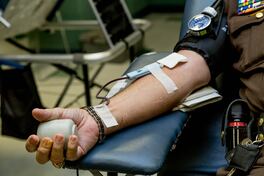
The Challenge
Is this actually a big problem though? Well the answer seems to be a resounding yes. There is a decent variation across specialties, but an average of 39.1% of patients undergoing major surgery will have anaemia. And the extent of anaemia doesn’t have to be huge to have an impact - a threshold of 130g/L seems to consistently be the point below which risk increases. This risk also appears to be a progressive - the more anaemic you are, the higher your perioperative risk. An interesting side note pointed out by Professor Klein here was the impact on women. He described how the WHO definition of anaemia in women was based on a number of population studies in the 1950s; populations which likely included a decent incidence of iron deficiency. The concern here is that a degree of pathology may have crept into the definition of ‘normal’. The problem is that women bleed in exactly the same way as men, and actually the on-average smaller circulating volume compared to men means that there is an increased impact from an equivalent blood loss. This is actually demonstrated in some studies with a demonstrably worse outcome in women. Using separate haemoglobin thresholds for women may therefore be physiologically unjustified and visibly harmful. Indeed, the most recent consensus guidance advises us to just use a threshold of 130g/L to define anaemia, regardless of gender. (https://onlinelibrary.wiley.com/doi/full/10.1111/anae.13773)
Interesting note from Prof Andre Klein: WHO anaemia definition for women based on population data that probably included iron deficiency anaemia i.e. the pathology integrated into what is 'normal', giving the lower threshold #periopanaemia
— Thomas Heaton (@tomheaton88) March 28, 2019
Really important point by Prof Klein - Hepcidin levels notably increase after the surgical insult. Post-op oral iron is liekly to do nothing #periopanaemia
— Thomas Heaton (@tomheaton88) March 28, 2019
Implementing Change
Dr Rachel Brown followed with another great summary of driving quality improvement work forward in Manchester through their pre-operative anaemia pathway. Through the conception and development of a pilot scheme they were able to show some similarly impressive results in reducing transfusion requirements locally. She outlined some of the challenges faced in doing this, many of which relate to the fairly discordant nature of perioperative pathways currently. As already noted, the timeframe for intervention is tight, and historically the pre-operative assessment has been more about just gathering information rather than doing anything about it. As a haematologist by background, she provided some useful insights into the service and some of the pathways that may be less familiar to us anaesthetists/intensivists which are often needed for day admission for IV iron therapy. Again a theme here was one of resources. Even the development of a service such as this, with pretty well demonstrated benefits, was a challenge. On the short term horizon the increasingly effective therapies for other conditions, she highlighted an upcoming weekly treatment for myeloma as an example, would likely take up more capacity and lead to further competition for resources.
The final speaker was Dr Caroline Evans. She is a consultant anaesthetist from Cardiff who described a similar story in improving pre-operative anaemia care locally to her. The same challenges were being identified in terms of a high incidence of pre-operative anaemia and the subsequent transfusion demands - her own practice being in cardiothoracic anaesthesia. The implementation of a pathway to tackle this faced a number of problems that had been touched on already. Getting agreement for a policy that involves a wide range of professionals and specialties is no small task, never mind finding capacity to deliver an intervention that needs space, staff and time. These are recurring themes. An example of this being tackled is the attempt to ensure that only a single admission is needed for IV iron therapy, which has triggered a switch to the use of Monofer. Just having to get people to come back for a second infusion, with all the associated demands on services, never mind the impact on patient lives, had quite a detrimental impact on actually achieving the goal of iron repletion.
Final Thoughts
As always please leave any comments and ideas below. I have linked a few useful resources below if you want to read a bit more about the topic. I have to say a big thank you to PeriopMan and all the speakers for a really interesting and excellently hosted afternoon. I’m completing my application for the October event straight away.
Hopefully see you there.
Tom
Further Reading
- Anaesthesia. Special issue: Patient optimisation before surgery. 2019. 74(1). https://onlinelibrary.wiley.com/toc/13652044/2019/74/S1
- Munoz, M. et al. International consensus statement on the perioperative management of anaemia and iron deficiency. 2017. 72(2):233-247. https://onlinelibrary.wiley.com/doi/full/10.1111/anae.13773
- NICE. Anaemia - iron deficiency. 2018. https://cks.nice.org.uk/anaemia-iron-deficiency#!topicSummary
- Munoz, M. et al. ‘Fit to fly’: overcoming barriers to preoperative haemoglobin optimization in surgical patients. BJA. 2015. 115(1):15-24. https://academic.oup.com/bja/article/115/1/15/238472
- Froessler, B. et al. The Important Role for Intravenous Iron in Perioperative Patient Blood Management in Major Abdominal Surgery: A Randomized Controlled Trial. Annals of Surgery. 2016. 264(1):41-46. https://journals.lww.com/annalsofsurgery/Fulltext/2016/07000/The_Important_Role_for_Intravenous_Iron_in.9.aspx
- Australian Red Cross Blood Service. https://transfusion.com.au/
- Heaton, T. Iron deficiency anaemia. The Gasman Handbook. 2018. http://www.thegasmanhandbook.co.uk/iron-deficiency-anaemia.html
 RSS Feed
RSS Feed
